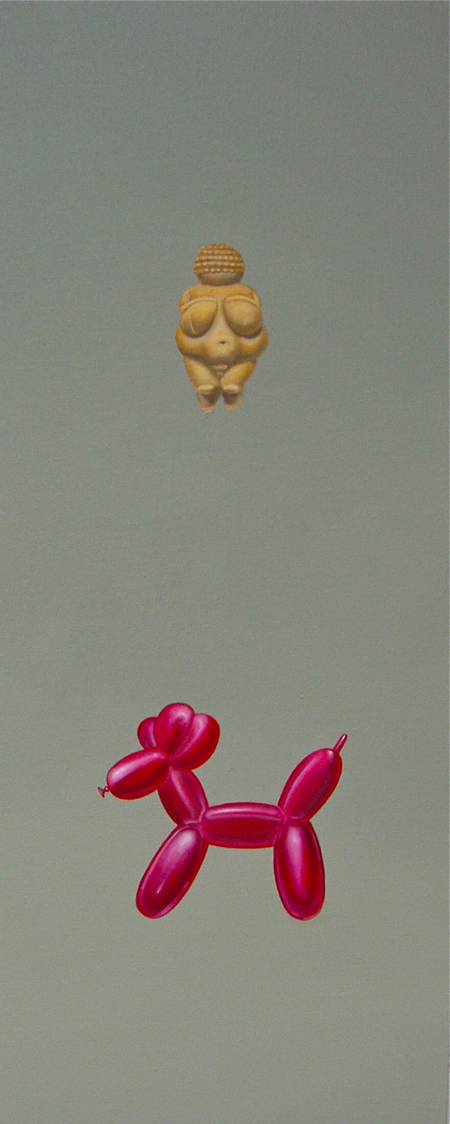
Continuing through November 29, 2014
The invitation to Bruce Richards, "Future/Past" consists of a cut-out of Richards’ diptych paintings “Before" and "After.” Placed in shaped frames, the stylized rendition of a woman’s lower torso was inspired by a performance by Marina Abramović during which she cut a pentagram into her belly with a razor blade. Perhaps off-putting to some at first glance, it is an apt introduction to an artist whose paintings and sculptures are informed by well-known and obscure facets of art history. Richards also delves into politics, dives into the mire of personal relationships and eviscerates a few sacred cows, all deployed with intelligence, wit and humor.
Not strictly a retrospective, the show spans several decades during which Richards created paintings based on any theme occupying his mind at a given time; also included are the artist's restructuring some of such narratives into three-dimensional works. Richards’ titles, an essential part of the total work, offer clues to thought processes that appear to run at warp speed but, given the quality of the work, are invested with care and patience in their execution.
His fascination with art history takes form in paintings like “Darwinian Theory” (2007), in which the Woman of Willendorf, created roughly 32,000 BC floats above Jeff Koons’ balloon dog. Contemplating the correlation between the voluptuous breasts of the Venus and the canine’s inflated limbs, and then the drastic contrast in materials, one might ruminate on the nature of species’ evolution as compared with that of humanity’s technological and social evolution.
The Woman also appears in “Minotaur and Sleeping Woman” (2013), which similarly pairs her with Picasso’s “Bull’s Head” that the master assembled in 1942 from a bicycle seat and handlebars. It’s said that the image came to Picasso in a flash and that is, says Richards, how many of his own works come into being, first in a flash and then a long trajectory of thought and process.
Tattoo art has earned its place in the artist’s oeuvre. “Ports O’Call” (2007) depicts an arm covered by a “sleeve” of modern art icons that allude to the multitude of harbors embedded in sailors’ memories. “Fountain of Youth,” another arm tattooed with art historical imagery, bears a hand pointing us forward to a future that lies beyond the picture frame.
The painting is one of a series of reverent (meaning bent down as in a bowing position) skulls based on Richards’ interactions with his father during the last year of his life. “As Bees in Honey Drown (I)" (2012) also has a cautionary wellspring, only here the skull is emblazoned with the word “Desire.” It visually references Ed Ruscha's text art, but Richards alludes to bees and their instinct, in time of famine, to consume their own honey and become addicted to it, a sobering equation. Close study of the skull itself offers clues that desire takes multiple forms. Breakage along its nasal area, by wear or design, suggests female genitalia.
The Bible as codex of values comes into play in the watercolor “Cain” (1982), with a snake slithering out from a boy scout cap, and the sculpture (1989-2012) featuring the snake, cap and a boy scout hatchet embedded in a tree stump. Both elaborate the theme of the timeless battle between good and evil. The theme also plays out in the painting “Love Thy Neighbor” where the two letter “O’s" are pierced by bullet holes. The implication that "I am not my brother’s keeper” is a reflection on our zeitgeist rather than amounting to a pious moral admonition.
Samples from his “Modern Life” series, are images of intricately balanced houses of cards, the implication being as obvious as anything Richards has ever done. “Dream of Kings” (2007) in which the cards are precariously balanced atop a skull, speaks volumes about illusions of security.
Richards shifts gears in the series “Course of Empire” (referencing Thomas Cole’s 1836 painting of the same title), consisting mainly of burning tires, ostensibly set ablaze by demonstrators — or a disgruntled artist — fed up with the status quo. “Monogram” (2009) replaces Rauschenberg’s famous mountain goat in a tire with a flaming painter’s easel. The series amounts to a call to resist complacency.
Finally, one cannot conclude any discussion about this show without mentioning Richards’ depictions of the fig leaf, the dubious adornment that historically covers figures’ modesty but which really calls attention to their nakedness. Richards has made elegant porcelain versions that poke sly fun at self-appointed arbiters of taste who conjure up the ghost of Queen Victoria.
Published courtesy of ArtSceneCal ©2014
